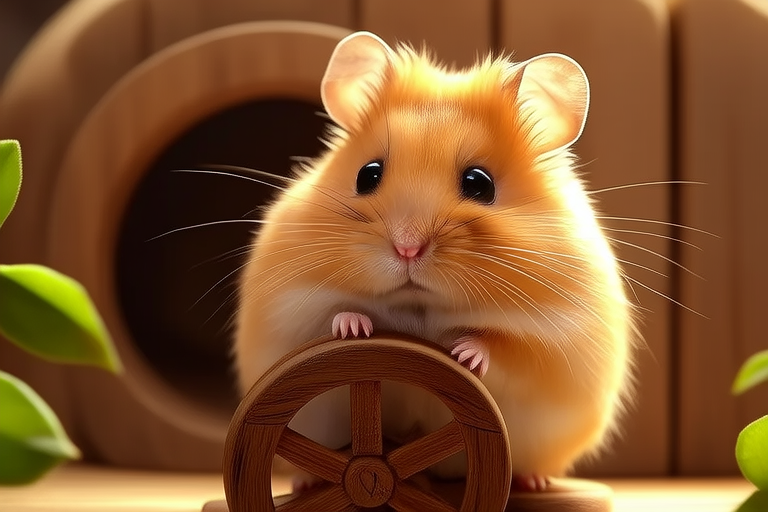Top 10 Fun Facts About Golden Hamsters You Didn’t Know
Golden hamsters, also known as Syrian hamsters, are popular pets around the world. Their cute faces, soft fur, and small size make them adorable companions. However, there’s more to these little creatures than meets the eye. Here are ten fun and fascinating facts about golden hamsters that will surely surprise you.
1. They’re Night Owls
Did you know that golden hamsters are nocturnal? This means they are most active during the night and sleep during the day. While this might seem like a downside for pet owners who want to play with their hamsters during the day, it can be managed by adjusting your schedule or playing with them just before bedtime. Understanding their natural habits helps create a harmonious living environment.
2. The Hamster’s Secret Stash
One of the most endearing behaviors of golden hamsters is their love for hoarding food. In the wild, they gather seeds and grains to store for lean times. In captivity, this behavior translates into collecting treats and hiding them in various corners of their cage. Watching them carry their favorite snacks in their cheeks can be both amusing and heartwarming.
3. Solitary by Nature
Unlike many other rodents, golden hamsters are solitary animals. In the wild, they live alone except during mating season. This solitary nature makes them less tolerant of sharing their living space with others. Keeping multiple hamsters together can lead to fights, stress, and even injuries. Therefore, it’s best to keep each hamster in its own cage unless you’re planning to breed them under professional supervision.
4. The Speedy Swimmers
Contrary to popular belief, golden hamsters are actually good swimmers. They have strong limbs and a streamlined body that aids in swimming. However, while they can swim, it doesn’t mean they enjoy it or should be encouraged to do so frequently. Water activities should be limited to occasional baths to maintain hygiene, as hamsters are more prone to catching colds than humans.
5. Lifespan in Captivity
In the wild, golden hamsters have a relatively short lifespan, usually between one and two years. However, when kept as pets, their life expectancy can increase to up to three years. Proper diet, regular exercise, and a clean living environment are key factors in extending their lives. Providing a stimulating environment with toys and tunnels can also contribute to their overall health and happiness.
6. The Name Game
The term ‘golden’ in golden hamsters refers to their original color, which is a light brownish-gold. However, through selective breeding, many different colors and patterns have been developed. From black and white to spotted and albino, there’s a wide variety of golden hamsters available today. This diversity has made them even more appealing as pets.
7. Burrowing Behavior
Burrowing is an essential part of a golden hamster’s life. In the wild, they dig extensive burrows underground to live in. As pets, they still exhibit this behavior, often digging in the bedding material in their cages. Providing them with tunnels and nesting boxes can satisfy their need to burrow and explore. This enriching activity keeps them mentally stimulated and physically active.
8. The Hamster’s Sense of Smell
Golden hamsters have an excellent sense of smell, which they rely on for finding food, recognizing territory, and identifying mates. Their keen sense of smell also plays a crucial role in their social interactions. When introducing a new hamster to the family, their sense of smell helps them recognize and accept new members. It’s important to handle new hamsters carefully to avoid overwhelming their senses.
9. Unique Teeth Structure
Hamsters, like all rodents, have continuously growing incisors. To prevent overgrowth, they need to gnaw on hard objects regularly. Providing safe and appropriate chew toys is vital for maintaining their dental health. Without proper chewing, their teeth could grow too long, causing discomfort and potential health issues. This unique dental structure is one of the reasons why hamsters are such enthusiastic chewers.
10. Sleep Patterns
Golden hamsters have polyphasic sleep patterns, meaning they sleep for short periods throughout the day and night. During these naps, they enter REM sleep, where they dream. Observing a sleeping hamster can be quite charming, especially when they twitch or move their paws as if running in their dreams. Understanding their sleep patterns can help pet owners provide a quiet and peaceful environment for their hamsters to rest.
Tips for Basic Care of Golden Hamsters
Maintaining a healthy and happy hamster requires proper care. Here are some basic tips:
- Diet: Feed them a balanced diet consisting of high-quality hamster pellets, fresh vegetables, and fruits. Avoid feeding them foods high in sugar or fat.
- Housing: Provide a spacious cage with plenty of bedding and nesting materials. Include tunnels and toys to keep them entertained.
- Cleaning: Clean their cage regularly to prevent ammonia build-up and reduce the risk of respiratory infections.
- Grooming: Regularly brush their fur to prevent matting and check for any signs of illness or injury.
- Handling: Handle them gently and frequently to get them used to human contact and reduce stress.
By following these tips, you can ensure that your golden hamster leads a long and healthy life. These fascinating creatures bring joy and companionship to many homes, and understanding their unique characteristics can enhance the bond between you and your pet.
